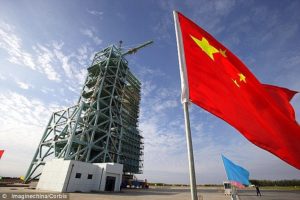
China’s People’s Liberation Army (PLA) views space warfare as an important component of its concept of war, and is developing a range of capabilities and tactics to carry out space operations, as well as bolstering its organizational and command and control capacity to enable such operations, according to the U.S. Defense Intelligence Agency (DIA) report China Military Power: Modernizing a Force to Fight and Win, published in January 2019.
The DIA’s China Military Power report provides a U.S. perspective on the current and evolving state of China’s military and its ability to wage war, and argues that the PLA is at a critical turning point in this ability as it matures a growing number of technologies and operational concepts. Space operations feature prominently in this regard, according to the DIA, and is regarded by Chinese military thinkers as a critically important aspect of future warfare.
“Strategists in the PLA regard the ability to use space-based systems and deny them to adversaries as central to enabling modern informatized warfare. As a result, the PLA continues to strengthen its military space capabilities despite its public stance against the militarization of space,” the DIA report says.
“Space operations probably will form an integral component of other PLA campaigns and serve a key role in enabling actions to counter third-party intervention during military conflicts,” it adds.
The China Military Power report emphasizes the PLA’s growing reliance on a range of satellite applications for its operations, to include Earth observation, communications, and positioning, navigation, and timing (PNT) satellites, much like the military of its U.S. rival. China Military Power also highlights, however, Beijing’s continuing efforts in developing counterspace capabilities and anti-satellite weapons.
“China continues to develop a variety of counterspace capabilities designed to limit or prevent an adversary’s use of space-based assets during crisis or conflict. In addition to the research and possible development of satellite jammers and directed-energy weapons, China has probably made progress on kinetic energy weapons, including the anti-satellite missile system tested in July 2014. China is employing more sophisticated satellite operations and probably is testing on-orbit dual-use technologies that could be applied to counterspace missions,” the report says.
“Space and counterspace capabilities—like missile forces, advanced air and seapower, and cyber capabilities—are critical for China to fight and win modern military engagements. To support various requirements, China has built a vast ground and maritime infrastructure enabling spacecraft and space launch vehicle (SLV) manufacture, launch, C2, and data downlink,” China Military Power adds.
These capabilities, according to the DIA, include electronic warfare capabilities, laser weapons, as well as direct-ascent anti-satellite missiles.
“The PLA is acquiring a range of technologies to improve China’s counterspace capabilities. China is developing antisatellite capabilities, including research and possible development of directed-energy weapons and satellite jammers, and probably has made progress on the antisatellite missile system that it tested in July 2014. China is employing more sophisticated satellite operations and probably is testing dual-use technologies that could be applied to counterspace missions,” the report states.
China Military Power is not just a catalogue of capabilities that the DIA believes China’s PLA is testing or possesses, it also cites Chinese military writings on operational concepts, doctrine, and strategic theory that are often authored by serving as well as retired PLA officers.
“China has not publicly acknowledged the existence of any new programs since it confirmed it used an antisatellite missile to destroy a weather satellite in 2007. PLA writings emphasize the necessity of “destroying, damaging, and interfering with the enemy’s reconnaissance…and communications satellites,” suggesting that such systems, as well as navigation and early warning satellites, could be among the targets of attacks designed to “blind and deafen the enemy.”,” the China Military Power report asserts.
China Military Power also states that the PLA’s Strategic Support Force – the organisational entity responsible for carrying out space operations among other Chinese strategic missions – is capable of carrying out multidomain operations in space, cyberspace, and the electromagnetic spectrum (i.e. electronic warfare) in support of traditional land, sea, and air operations.
 “The PLA’s Strategic Support Force (SSF), established in December 2015, has an important role in the management of China’s aerospace warfare capabilities. Consolidating the PLA’s space, cyber, and electronic warfare capabilities into the SSF enables cross-domain synergy in “strategic frontiers.” The SSF may also be responsible for research, development, testing, and fielding of certain “new concept” weapons, such as directed energy and kinetic energy weapons. The SSF’s space function is primarily focused on satellite launch and operation to support PLA reconnaissance, navigation, and communication requirements,” the DIA report says.
“The PLA’s Strategic Support Force (SSF), established in December 2015, has an important role in the management of China’s aerospace warfare capabilities. Consolidating the PLA’s space, cyber, and electronic warfare capabilities into the SSF enables cross-domain synergy in “strategic frontiers.” The SSF may also be responsible for research, development, testing, and fielding of certain “new concept” weapons, such as directed energy and kinetic energy weapons. The SSF’s space function is primarily focused on satellite launch and operation to support PLA reconnaissance, navigation, and communication requirements,” the DIA report says.
It is this ability to conduct multidomain operations that is spurring the U.S. and a number of its allies (such as Japan) to modernise their defence postures and strategies accordingly.
“The report disregards facts and [displays] a cold-war and zero-sum mentality. The report speculates on China’s path, strategic intention and defence-building,” said Chinese Foreign Ministry spokesperson Hua Chunying. “China urges the US military to reasonably and objectively treat China’s military development and safeguard the military ties between the two countries,” she said.
The DIA report is “extremely unprofessional and contains absurd accusations,” Hua added.





